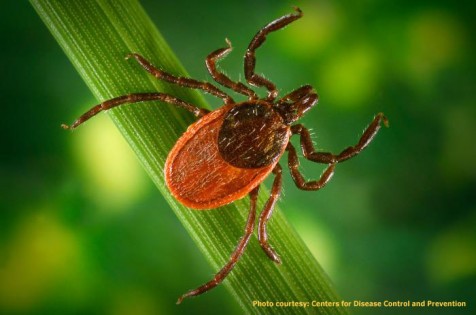
When outdoors, be alert for ticks
7 steps you can take to protect yourself, including a a self-check after outdoor activities
UM’s Fort Garry campus offers beautiful outdoor spaces to enjoy, including the many trees and other vegetation that enhance our campus experience.
It’s important to be aware that when spending time outside, especially in wooded areas or spaces with tall grass or other vegetation, you may encounter a tick. To prevent the transmission of Lyme disease or other tick-borne illnesses, it should be removed immediately and carefully from the body. Read on for preventative measures you can take to stay safe.
Take these 7 steps to protect yourself
1. Limit your time in heavily wooded or grassy areas, and be alert for possible ticks that may be on your clothing or skin, including your scalp.
2. Take preventative measures such as wearing a hat and long sleeves and tucking pants into your socks to help to deter ticks, which are more common in wooded areas and long grass.
3. Use a repellent. “DEET is considered safe by Health Canada, so I have no problem recommending it [to repel ticks],” says UM entomologist Kateryn Rochon. She also notes that there is a newly approved chemical now available in Canada called Icaridin.
4. Immediately perform a self-check upon coming back indoors after spending time outside. That includes checking children and pets as well.
5. Familiarize yourself with instructions on tick removal. You can prevent the transmission of Lyme disease or other tick-borne illnesses by immediately and carefully removing it from the body.
6. Monitor for symptoms. If you have been bitten by a tick that carries the bacteria that causes Lyme disease, symptoms will typically be noticed in 3-30 days. Symptoms of Lyme disease may vary, but generally include a rash at the site of infection, headaches, fever, fatigue, chills, and muscle aches. If in doubt, see your doctor.
7. Seek medical attention. If you cannot remove the tick yourself, seek medical attention to assist. It is good practice to take a photo of the removed tick or place it in a bag in order to identify the type of tick and the potential need for further medical attention.
More about blacklegged ticks

Black-legged tick.
Deer ticks, also known as blacklegged ticks, are approximately 2 to 5 mm in length; and are distinctly bright red and dark brown in colour. They can be very small and look like “black sesame seeds,” according to Rochon.
“Check yourself, check your pets, and your children. Try to prevent attachment by covering your skin with repellent and clothing,”
Black-legged ticks cannot jump or fly. Instead, they seek hosts by climbing on vegetation such as grasses or shrubs and waiting for a host to rub against them. The tick will attach to a human in order to feed on their blood. The bite is painless, and you may not even feel it. The best way to know if you have been bitten by a tick is to perform a self-check after being outside.
In Manitoba, there are several species of ticks but only one species, the Deer tick (or blacklegged tick), is responsible for spreading tick-borne diseases to humans.
Additional resources on ticks and removing ticks
Tips on staying safe during tick season
Check yourself, your children and your pets
How to identify ticks (Health Canada)
UM tick series (videos)






